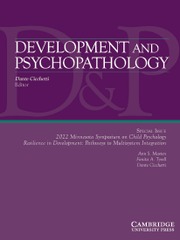Article contents
Violence exposure and neural systems underlying working memory for emotional stimuli in youth
Published online by Cambridge University Press: 16 November 2017
Abstract
Violence exposure during childhood is common and associated with poor cognitive and academic functioning. However, little is known about how violence exposure influences cognitive processes that might contribute to these disparities, such as working memory, or their neural underpinnings, particularly for cognitive processes that occur in emotionally salient contexts. We address this gap in a sample of 54 participants aged 8 to 19 years (50% female), half with exposure to interpersonal violence. Participants completed a delayed match to sample task for emotional faces while undergoing functional magnetic resonance imaging scanning. Violence-exposed youth performed worse than controls on happy and neutral, but not angry, trials. In whole-brain analysis, violence-exposed youth had reduced activation in the left middle frontal gyrus and right intraparietal sulcus during encoding and the left superior temporal sulcus and temporal–parietal junction during retrieval compared to control youth. Reduced activation in the left middle frontal gyrus during encoding and the left superior temporal sulcus during retrieval mediated the association between violence exposure and task performance. Violence exposure influences the frontoparietal network that supports working memory as well as regions involved in facial processing during working memory for emotional stimuli. Reduced neural recruitment in these regions may explain atypical patterns of cognitive processing seen among violence-exposed youth, particularly within emotional contexts.
Information
- Type
- Regular Articles
- Information
- Copyright
- Copyright © Cambridge University Press 2017
Footnotes
This research was supported by National Institute of Child Health and Human Development Grant T32-HD057822 and National Institute of Mental Health Grants K01-MH092526, R01-MH103291, and R01-MH106482.
References
- 10
- Cited by

